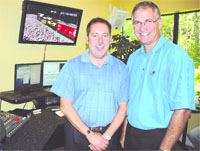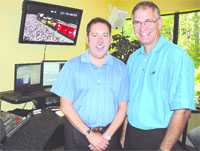
Moving Pictures
Visual Concepts Finds a New Niche in Web 2.0

Ric Serrenho and Steve Shaw built their multimedia business on the premise that visual marketing would stay strong, but the channels would change dramatically.
When Steve Shaw and Ric Serrenho founded Visual Concepts, a lot of thought went into the companys name. The duo had a feeling that video production, their field of expertise, would soon change and dramatically. The advent of the Internet proved them right, and today, the business continues to evolve with changing technology, but the visual aspect has stayed very much the same.
Ric Serrenho says the fast-evolving Internet does more than diversify the business model at Visual Concepts, the company he co-founded with Steve Shaw more than two decades ago.
Rather, its also a great equalizer, directing people of all types to one place their computers for information, entertainment, and connectivity.
The Web makes the world flat, he said. Almost everything in the world gets there eventually, and the Web plays a role in almost everything.
With that realization, Shaw and Serrenho are moving confidently into the next phase of their business, which specializes in multimedia-based marketing communications.
The partners founded Visual Concepts in Easthampton, Conn., in 1986, after working together at Hartfords WTNH Channel 8 as part of its news team. At the time, the Internet was still an unknown entity, but video production was something Shaw and Serrenho had grown to know well. They also saw a potential niche for their talents in corporate communications.
Were good at telling stories, said Shaw. We know how to marry words with pictures, and we thought we could offer something different to the corporate world.
Visual Concepts began providing video-based marketing and business-development materials for their clients materials such as new-product introductions, training videos, video press releases, and visual components for meetings.
A lot of it was similar to producing live television, which we knew a lot about, said Shaw, noting that the business grew alongside new technology, gradually adding on new capabilities as opportunities arose. When the Internet started to evolve, that led to new and interesting things, such as animation and Web graphics. We strongly believed then, as we do now, that the Internet was going to be our future.
The Wicked Web
Serrenho agreed, adding that not only has the Web opened up a whole new world of work for Visual Concepts, it has also allowed the firm to advance more quickly onto new avenues as it stays on pace and sometimes leads the technology race.
Our roots are in video, but now the Web is becoming video, he said. Web and video technologies are combining and integrating to create something weve never seen before, and frankly, right now were enjoying that fact. The pipeline can now handle the kind of video we love to do online.
Today, the Web factors into just about everything the company does. Having grown out of its original home in Easthampton, and later in Bloomfield, Conn., as well, Visual Concepts now owns its workspace in Windsor, Conn. Meeting staging for small and large corporations is still a part of the mix, as is electronic communications, Web design, programming, and online media production. Visual Concepts specializes in working with clients that manufacture or market consumer products, including Spalding, Peter Pan, Pilot Pen, and the Snapple Beverage Group, but also has a healthy list of clients in the non-profit sector, such as the Anti-Defamation League, Yale-New Haven Hospital, and the Hartford-Springfield Economic Partnership.
In addition, Serrenho said the firm will often work with other marketing agencies to serve as their video-production arm. Locally, Paul Robbins Associates often works with the company. Regardless of the relationship, though, Serrenho added that the list is only growing as more companies of all types and sizes ramp up their online presence in response to consumer demand.
Companies are very conscious that were living in a Web world, he said. They know consumers are getting a lot of their information there. What we do in response is design sticky sites the kind that people will keep going back to. We learn about other peoples businesses to make each site a custom piece like furniture makers. No two projects are alike, and thats what makes them effective.
Maintenance Plan
Over the years, Serrenho added, Visual Concepts has developed a strength in not just developing sites, but maintaining them with regular information and technology updates.
Nestled in an industrial park in Windsor, Visual Concepts is also positioned to take advantage of the business climate in both Connecticut and Western and Central Mass., in addition to clients in New York and, increasingly, New Jersey. Serrenho said its a business line with national reach, but theres also some local loyalty that keeps him, Shaw, and their 15-person team grounded.
We work with both large and small companies some are $36 billion a year corporations, and others are small, independent businesses, he said. We have a big base of business in Western Mass., in part because we made a commitment to the area. We understand that Northern Conn. and Western Mass. need each other, and that theres a rich business tradition to uphold. Most importantly, though, theres also a lot of opportunity to be had.
As the company continues to move forward, its branching out into new geographical areas as well as new areas of focus. Serrenho said a new niche in higher education is starting to develop, spurred in part by the large number of colleges and universities in the region. In addition, he said existing relationships with long-held clients are also starting to broaden.
Spreading the Word
Through its work with Spalding, for instance, Visual Concepts is now delving more into viral marketing and social media, in an effort to better reach the age-14-to-28 demographic. Viral videos (those that can be easily spread from person to person), featuring athletes such as Olympic softball player Jennie Finch and 2007 top NBA draft pick Greg Oden, have been created and posted on YouTube, particularly at the new Spalding channel.
People are much more aware that reaching out on the Web in this way is something you have to think about, said Serrenho, so there are so many more ways we can apply our skills.
Shaw concurred.
Everyone is waking up to social networking as a business tool, he said. Plus, this is a great example of how we typically move ahead: by moving into areas that havent previously been explored.
Overall, Serrenho said Visual Concepts never strays far from its beginnings as a video production house, but one decision early on in the firms history helped pave the way toward bigger, better, and constantly evolving projects.
We had the choice, early on, to call ourselves Video Concepts, he said. We had a feeling that things were going to keep changing, and someday our jobs were going to look very different. Becoming Visual Concepts was a nod to our belief that we were going to be able to grow and sustain.
Shaw added that in tough economic times like those we currently face, adaptation to market shifts is one key to success.
Results are important, he said. We must have an impact on our clients bottom line.
And in a flat world, the bottom line isnt so hard to find if you know where to look.
Jaclyn Stevenson can be reached at[email protected]





